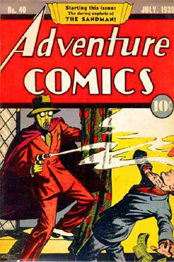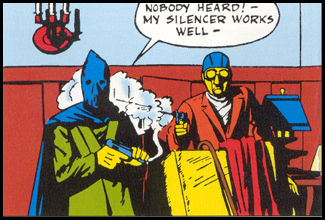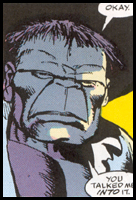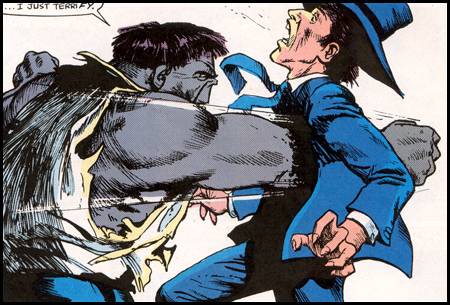 THE SANDMAN versus THE TARANTULA
THE SANDMAN versus THE TARANTULAThe Tarantula Strikes (DC)
Where: Adventure Comics #40 When: July 1939
Why: Unknown How: Larry Dean
Quick Fix...
My word! A comedy of errors here at the Infinite Wars as I slide into lateness once more, and accidentally delete the previous poorly drawn Comik-Politik cartoon. Apologies particularly to the fangirls from WFA who were following the much appreciated link, and finding only dead air.
Speaking of dead air, today is, of course, Halloween!
To mark the occasion we've spent the latter half of the month hovering around the sinister and macabre, and as easy as it could've been to go with vampires and zombies, I thought it might be fun to take this holiday of nightmares and use it as a vehicle for a couple of interesting little posts with a sleepy theme to them.
Now, it goes without saying that I'm a big fan of the Spidey villain.
I thoroughly enjoyed Spider-man 3, and personally regarded Sandman, who is among my favourite Spidey villains, one of the true undisputed highlights of the film. Therefore, it's with that qualifier that I make the curmudgeonous statement: There is only one true Sandman in the DC Universe, and he doesn't go down especially well with eye-liner or Siouxsie and the Banshees.
Wesley Dodds debuted in New York World's Fair Comics #1, and quickly became a recurring staple of Adventure Comics from NAP, in the late thirties.
The character straddled the pulpy line between mysteriouso, gadget-wielding detectives like The Shadow, and the new wave of super-hero ushered in by Superman and Batman in sister titles; Action, and Detective Comics.
Much like Batman, it would only take a few years for the character to lose much of his connection to the pulp stories of the previous era, joining the superhero fraternity with the initiation of a new colourful suit, and junior sidekick.
I'm by no means any kind of expert on the Golden Age, but it was an affinity for characters like the Sandman that influenced the earliest iterations of my own work, The Kirby Martin Inquest. The Sandman would no doubt have featured much sooner in the Infinite Wars, if it were not for the nature of his character as a subversive combatant, and his appearances here in mostly short stories.
Indelible influences from a childhood of Phantom stories written by Lee Falk and drawn by grossly underrated American masters like; Raymond Moore and Wilson McCoy; probably primed me for a fascination with characters of this mould.
In the same way one views the wide array of characters from contemporary Marvel and DC comics; the Sandman represents a different slice of the same cultural pie, calling upon popular influences, themes and zeitgeists of the time.
Holding true to his ties to the pulp corner of this developing universe, the Sandman lacks the colourful rogues gallery of recurring villains that would lead to a distinct divergence between this character, and a Batman. The Sandman's stories are largely isolated tales more about corruption and common villainy, than the garrish, or costumed.
That's not to say there weren't memorable characters, and certainly The Tarantula emerges as one of the more visually stimulating villains.
It would be this character that would serve as one of many inspirations for the 1990s revival in, Sandman Mystery Theatre. This Vertigo version of the classic Sandman (written by Matt Wagner) would dramatically redefine many early stories, developing them in more removed ways than typical retellings of past tales [similar to Wagner's later Batman work]. This was far from an Ultimate affair, despite being perhaps more worthy of the prefix than those that use it.
Wagner largely takes only the basic premise of the original tales, setting his series in 1930s New York, where the Sandman tracks a serial kidnapper and abusive version of the The Tarantula. This original creation highlighted the uncompromising shift in Wagner's overall approach, acting free of the social constraints that kept the Sandman within certain parameters of specifics, as mature as the broader concepts may have been.
Wagner blows the character out into a world of intrigue and incestuous bickery between disgruntled family members, and exposes the homicidal tendencies of an emotionall withdrawn weakling. So specific is Wagner's direction, that it specifically references the motivations of the original Tarantula kidnapper.
 Wesley Dodds, having learnt of the kidnapping ransom of actress Vivian Dale, travels to her home by cover of night, putting himself to bed in effigy to stalk the streets as the sinister Sandman.
Wesley Dodds, having learnt of the kidnapping ransom of actress Vivian Dale, travels to her home by cover of night, putting himself to bed in effigy to stalk the streets as the sinister Sandman.Evading the police net, Sandman lurks the grounds of Ms. Dale's estate where police hold all houseguests and servants as suspects, while waiting for the Tarantula's next message.
With a mystery surrounding the Tarantula's methods for whisking the actress away unseen, Dodds already carries the theory that she may not have left her large, ancient mansion. A theory that ultimately proves to have some credence when he follows the Tarantula to a secret hallway hidden within the walls.
With the aid of his gas gun, the Sandman puts to sleep the gunman who guards a bound Vivian hidden within a secret room. Following the labyrinth of hidden passages through the old home, Sandman discovers a room empthy that should be filled -- the guest room of Mr. Crossart, a man who had objected to the police's treatment of those staying with Ms. Dale.
 The Sandman proves to be Crossart's undoing, drawing fire from the villain's pistol with the use of a pillow garbed in his hat and coat, placed carefully across the room at the guest's desk. The Sandman is able to turn the tables, putting the Tarantula to bed, which is where the police discover a sleeping Vivian Dale, with the thwarted crooks tied to her bedpost -- with a sprinkle of sand on each: the calling card of the Sandman!
The Sandman proves to be Crossart's undoing, drawing fire from the villain's pistol with the use of a pillow garbed in his hat and coat, placed carefully across the room at the guest's desk. The Sandman is able to turn the tables, putting the Tarantula to bed, which is where the police discover a sleeping Vivian Dale, with the thwarted crooks tied to her bedpost -- with a sprinkle of sand on each: the calling card of the Sandman!Perhaps as interesting as this six-page short story and it's responsibility for inspiring four full issues of work six decades later, is that DC credit the story's art to Bert Christman, using the pseudonym Larry Dean, but are unable to cite a writer.
A tragedy, given the kudos deserved for being a crucial part of these great Sandman tales, before the character would succumb to the mediocrity and loss of identity as yet another costumed hero.
Wesley Dodds may have been succeeded by his forties sidekick Sandy, but I can't help but regard this character as the one-and-only true Sandman at DC comics.
 The Fix: 2 The Story: 4
The Fix: 2 The Story: 4Winner: Sandman
Wesley Dodds may have been succeded by his forties sidekick Sandy, but I can't help but regard this character as the one-and-only true Sandman. His early adventures have been collected as "The Golden Age Sandman Archive Edition" from DC Comics. Likewise, the earliest issues of Matt Wagner's Sandman Mystery Theatre can be found in trade on Amazon.com. Each are a worthy addition to any collection!
 HULK versus THE STALKER
HULK versus THE STALKERThe Evil That Men Do! (Marvel)
Where: Incredile Hulk #335 When: September 1987
Why: Peter David How: John Ridgway
From the Sandman to the sleeper, as we wrap up our Halloween double feature with yet another tale of spooks and scares. This time, from a period in Bruce Banner's history when, much like the first days after his accident, he finds himself changing uncontrollably by moonlight into the grey-behemoth that is: The Incredible Hulk!
Peter David has been responsible for many iterations of the Hulk, and throughout the years has crafted some of the best regarded stories with the character. Among a plethora of memorable moments and stories is Hulk #340, which bares the famous Todd McFarlane drawn Wolverine cover, seen recently as a painted zombie variant by Arthur Suydam [Marvel Zombies #3].
Perhaps the most provocative quality of David's work was the psychological exploration of the characters of Bruce Banner and Hulk alike. Many stories not only spotlight the pathos of Banner as a cursed individual, but also the nature of Hulk as a character walking the line of hero and villain.
This stand-alone story presents a delicious double-header that paints a commentary about a social culture that derives trade from the glorification of violence, and the Hulk, whose relationship with violence presents a similar potential for downfall and loss of control.
Our story begins with a frightened girl attacked by a weedy man with claws who slinks out from under her bed at night, and clutches at her pyjamas. Wearing a wide floppy hat and cloak, the suited individual rakes at her eyes with a spray of blood, leaving her blindly stumbling for an exit out the window.
The Stalker pursues his victim through the suburban street, the girl too frightened to cry for help. Her salvation comes in the form of a solid grey mass standing in the middle of the street. Blinded, she collides with the fleshy obstacle, but immediately fills with a sense of reassurance and salvation.
The seedy Stalker tempts the Hulk to join him in his conquests of evil, but the Hulk declines, despite playfully contemplating the notion. It is the arrival of local law enforcement that prompts the Stalker to disappear into the night, the Hulk finding pardon for his menacing stature by sponsor of the grateful blinded girl.
A tour of the town allows Bruce Banner insight into the inner workings of the creature that stalked the suburban sprawl by night. He discovers a young man unwittingly in a predicament not unlike his own. A man who has surrendered to his demons, living a life of exiled solitude, worshipping devils in a collection of slasher movies, while getting drunk on cheap booze.
When Gil Jeffers falls asleep watching one of the many mind-numbing horror films he's seen hundreds of nights before, the spirit of the Stalker emerges, "free at last!" With night falling, Bruce Banner too falls victim to his hidden monster, transforming in the yard from where he spies.
The Stalker compels the Hulk to join him once more, successfully luring him with promise to free himself of the shackles of his other, and become the controlling bond like he has with the Jeffers boy. A boy whose hatred and imbalance has given birth to this monstrosity that would harass the girl he was too shy to talk to.



Suffering a taste of his own medicine, the Stalker flees the bar, throwing a police officer from his patrol car as he realises he is unable to awaken his drunken host, Gil Jeffers.
He flees desperately becoming the victim of this horror film, turning around streets only to find the grey visage of the Hulk waiting to crush his car, and the Stalker inside it! The killer flees on foot, reaching the home of Jeffers, but is still unable to shake him from his drunken slumber, forced to face the Hulk instead.
 You might debate that the Hulk sunk to the Stalker's level by killing him, but the lines between justice and villainy are grey in this example. Ultimately, the Stalker's gleeful claims he had rid himself of the interference of his host proved true. Destroyed, he left behind the comatose shell of Gil Jeffers, who apparently had been so consumed by his inner monster, there was little else left.
You might debate that the Hulk sunk to the Stalker's level by killing him, but the lines between justice and villainy are grey in this example. Ultimately, the Stalker's gleeful claims he had rid himself of the interference of his host proved true. Destroyed, he left behind the comatose shell of Gil Jeffers, who apparently had been so consumed by his inner monster, there was little else left.And with that sufficiently macabre conclusion, we put a close on our [belated] Halloween post. Stay tuned for "tomorrow's" Punch-Up as we run down the villains featured in our Ultimate Alliance Mondays, and stay tuned for spill-over as we keep the spotlight on the things that go bump in the night!
 The Fix: 5 The Issue: 5
The Fix: 5 The Issue: 5Winner: Hulk
David's script is brilliantly complimented by atmospheric pencils supplied by guest-artist Ridgway, whose spooky depiction of middle-American suburbia is rounded out by colours from Petra Scotese. Visually, it's very eighties, but it does the job tremendously, recalling the alternative styles of horror comics of the seventies and eighties. This issue is included with others in the first Peter David: Hulk Visionaries.

2 comments:
I remember this issue popping out of the batch because of the unusualness of John Ridgway's art. Not that there was anything wrong with it, quite the contrary - it just seemed very different to all the usually more glamourous marvel house-style. It fit the story perfectly!
Yeah, I think it's one of those rare gems in a Marvel run that departed in a really interesting way. I imagine most people lose it to the glut of McFarlane's work, etc.
It's a nice little story, too!
In my rush to turn posts in, I'm not sure I articulated how interesting the reflective dynamic is. The unspoken discussion of Hulk's nature as man or monster.
And, just to go hard left, it's great psychological issues in David's legendary work that always leaves me baffled by response to the Hulk movie. I thought it was great, and given the history, reasonably appropriate in terms of the maligned tone and themes.
Post a Comment